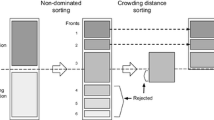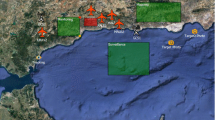Abstract
Due to recent booming of unmanned air vehicles (UAVs) technologies, these are being used in many fields involving complex tasks. Some of them involve a high risk to the vehicle driver, such as fire monitoring and rescue tasks, which make UAVs excellent for avoiding human risks. Mission planning for UAVs is the process of planning the locations and actions (loading/dropping a load, taking videos/pictures, acquiring information) for the vehicles, typically over a time period. These vehicles are controlled from ground control stations (GCSs) where human operators use rudimentary systems. This paper presents a new multi-objective genetic algorithm for solving complex mission planning problems involving a team of UAVs and a set of GCSs. A hybrid fitness function has been designed using a constraint satisfaction problem to check whether solutions are valid and Pareto-based measures to look for optimal solutions. The algorithm has been tested on several datasets, optimizing different variables of the mission, such as the makespan, the fuel consumption, and distance. Experimental results show that the new algorithm is able to obtain good solutions; however, as the problem becomes more complex, the optimal solutions also become harder to find.







Similar content being viewed by others
References
Adolf F, Andert F (2010) Onboard mission management for a VTOL UAV using sequence and supervisory control, chap. 19, InTech, pp 301–316
Allen JF (1983) Maintaining knowledge about temporal intervals. Commun ACM 26(11):832–843
Barták R (1999) Constraint programming: In pursuit of the holy grail. In: Week of Doctoral Students, pp 555–564
Bello-Orgaz G, Camacho D (2014) Evolutionary clustering algorithm for community detection using graph-based information. In: Evolutionary Computation (CEC), 2014 IEEE congress on, pp 930–937
Bello-Orgaz G, Ramirez-Atencia C, Fradera-Gil J, Camacho D (2015) Gampp: genetic algorithm for uav mission planning problems. In: Intelligent distributed computing IX. Springer International Publishing, pp 167–176
Bessière C (2006) Constraint propagation. Found Artif Intell 2:29–83
Bessière C, Meseguer P, Freuder E, Larrosa J (1999) On forward checking for non-binary constraint satisfaction. In: Jaffar J (ed) International conference on principles and practice of constraint programming, lecture notes in computer science, vol 1713. Springer, Berlin, pp 88–102
Bethke B, Valenti M, How JP (2008) UAV task assignment. IEEE Robot Autom Mag 15(1):39–44
Bin X, Min W, Yanming L, Yu F (2010) Improved genetic algorithm research for route optimization of logistic distribution. In: Proceedings of the 2010 international conference on computational and information sciences, ICCIS ’10, IEEE Computer Society, Washington, pp 1087–1090
Camacho D, Fernandez F, Rodelgo MA (2006) Roboskeleton: an architecture for coordinating robot soccer agents. Eng Appl Artif Intell 19(2):179–188
Deb K, Pratap A, Agarwal S, Meyarivan T (2002) A fast and elitist multiobjective genetic algorithm: NSGA-II. Evol Comput 6(2):182–197
Diaz D, Cesta A, Oddi A, Rasconi R, R-Moreno MD (2013) Efficient energy management for autonomous control in rover missions. IEEE Comput Intell Mag 8(4):12–24 Special Issue on Computational Intelligence for Space Systems and Operations
Doherty P, Kvarnström J, Heintz F (2009) A temporal logic-based planning and execution monitoring framework for unmanned aircraft systems. Auton Agent Multi-agent Syst 19(3):332–377
Fabiani P, Fuertes V, Piquereau A, Mampey R, Teichteil-Konigsbuch F (2007) Autonomous flight and navigation of VTOL UAVs: from autonomy demonstrations to out-of-sight flights. Aerosp Sci Technol 11(2–3):183–193
Fonseca C, Fleming P (1998) Multiobjective optimization and multiple constraint handling with evolutionary algorithms. A unified formulation. IEEE Trans Syst Man Cybern- A: Syst Hum 28(1):26–37
Geng L, Zhang Y, Wang J, Fuh J, Teo S (2013) Cooperative task planning for multiple autonomous uavs with graph representation and genetic algorithm. In: Control and automation (ICCA), 10th IEEE international conference on, pp 394–399. IEEE
Gonzalez-Pardo A, Camacho D (2013) A new CSP graph-based representation for ant colony optimization. In: IEEE conference on evolutionary computation (CEC 2013), vol 1, pp 689–696. IEEE
Gonzalez-Pardo A, Palero F, Camacho D (2014) An empirical study on collective intelligence algorithms for video games problem-solving. Comput Inform 34(1):233–253
Hao X, Liu J (2015) A multiagent evolutionary algorithm with direct and indirect combined representation for constraint satisfaction problems. Soft Comput 1–13. doi:10.1007/s00500-015-1815-1
Holland JH (1992) Adaptation in natural and artificial systems. MIT Press, Cambridge
Kendoul F (2012) Survey of advances in guidance, navigation, and control of unmanned rotorcraft systems. J Field Robot 29(2):315–378
Kuter U, Sirin E, Parsia B, Nau D, Hendlerb J (2005) Information gathering during planning for web service composition. Web semantics: science, services and agents on the World Wide Web 3(2):183–205. Selected papers from the international semantic web conference, 2004 ISWC, 2004 3rd international semantic web conference, 2004
Kvarnström J, Doherty P (2010) Automated planning for collaborative UAV systems. In: Control automation robotics and vision, pp 1078–1085. IEEE
Lee Yi, Kim YG (2008) Comparison of fuzzy implication operators by means of fuzzy relational products used for intelligent local path-planning of auvs. Soft Comput 13(6):535–549
Menendez HD, Barrero DF, Camacho D (2014) A co-evolutionary multi-objective approach for a k-adaptive graph-based clustering algorithm. In: Evolutionary computation (CEC), 2014 IEEE congress on, pp 2724–2731. IEEE
Merino L, Caballero F, Martínez-de Dios JR, Ferruz J, Ollero A (2006) A cooperative perception system for multiple uavs: application to automatic detection of forest fires. J Field Robot 23(3–4):165–184
Mouhoub M (2002) Solving temporal constraints in real time and in a dynamic environment. Tech. Rep. WS-02-17, AAAI
Mouhoub M (2004) Reasoning with numeric and symbolic time information. Artif Intell Rev 21(1):25–56
Nash A, Daniel K, Koenig S, Felner A (2007) Theta*: any-angle path planning on grids. In: Proceedings of the National Conference on Artificial Intelligence, vol 22. AAAI Press, MIT Press, Menlo Park, Cambridge, London, pp 1177–1183
Pascarella D, Venticinque S, Aversa R, Mattei M, Blasi L (2015) Parallel and distributed computing for uavs trajectory planning. J Ambient Intell Humaniz Comput 6(6):773–782
Pereira E, Bencatel R, Correia J, Félix L, Gonçalves G, Morgado J, Sousa J (2009) Unmanned air vehicles for coastal and environmental research. J Coast Res II(56):1557–1561
Ramirez-Atencia C, Bello-Orgaz G, R-Moreno MD, Camacho D (2015a) A hybrid MOGA-CSP for multi-UAV mission planning. In: Proceedings of the companion publication of the 2015 on genetic and evolutionary computation conference. ACM, pp 1205–1208
Ramirez-Atencia C, Bello-Orgaz G, R-Moreno MD, Camacho D (2015b) Performance evaluation of multi-UAV cooperative mission planning models. In: Computational collective intelligence. Springer International Publishing, pp 203–212
Rasmussen S, Shima T (2006) Branch and bound tree search for assigning cooperating uavs to multiple tasks. In: American control conference. IEEE, pp 6–14
Rodríguez-Fernández V, Menéndez HD, Camacho D (2015a) Automatic profile generation for uav operators using a simulation-based training environment. Prog Artif Intell 5(1):37–46
Rodriguez-Fernandez V, Ramirez-Atencia C, Camacho D (2015b) A multi-uav mission planning videogame-based framework for player analysis. In: Evolutionary computation (CEC), 2015 IEEE congress on. IEEE, pp 1490–1497
Rollon E, Larrosa J (2006) Bucket elimination for multiobjective optimization problems. J Heuristics 12(4–5):307–328
Rollon E, Larrosa J (2007) Multi-objective Russian doll search. In: Proceedings of the national conference on artificial intelligence, vol 22. AAAI Press, MIT Press, Menlo Park, Cambridge, London, pp 249–254
Savuran H, Karakaya M (2015) Efficient route planning for an unmanned air vehicle deployed on a moving carrier. Soft Comput 20(7):2905–2920
Schwalb E, Vila L (1998) Temporal constraints: a survey. Constraints 3(2–3):129–149
Soliday SW, et al. (1999) A genetic algorithm model for mission planning and dynamic resource allocation of airborne sensors. In: Proceedings, 1999 IRIS National Symposium on Sensor and Data Fusion. Citeseer
Tang L, Zhu C, Zhang W, Liu Z (2011) Robust mission planning based on nested genetic algorithm. In: Advanced computational intelligence (IWACI), 2011 fourth international workshop on, pp 45–49. IEEE. doi:10.1109/IWACI.2011.6159972
Vachtsevanos G, Tang L, Drozeski G, Gutierrez L (2005) From mission planning to flight control of unmanned aerial vehicles: strategies and implementation tools. Ann Rev Control 29(1):101–115
Van Veldhuizen D, Lamont GB, et al. (2000) On measuring multiobjective evolutionary algorithm performance. In: Evolutionary computation, 2000. Proceedings of the 2000 congress on, vol 1. IEEE, pp 204–211
Wagner T, Trautmann H, Martí L (2011) A taxonomy of online stopping criteria for multi-objective evolutionary algorithms. In: Evolutionary multi-criterion optimization. Springer, pp 16–30
Wu J, Zhou G (2006) High-resolution planimetric mapping from uav video for quick-response to natural disaster. In: Geoscience and remote sensing symposium, 2006. IGARSS 2006. IEEE international conference on. IEEE, pp 3333–3336
Zhou A, Qu BY, Li H, Zhao SZ, Suganthan PN, Zhang Q (2011) Multiobjective evolutionary algorithms: a survey of the state of the art. Swarm Evolut Comput 1(1):32–49
Zitzler E, Laumanns M, Thiele L (2001) SPEA2: Improving the strength pareto evolutionary algorithm. In: Eurogen, vol. 3242, pp. 95–100
Zitzler E, Laumanns M, Bleuler S (2004) A tutorial on evolutionary multiobjective optimization. In: Metaheuristics for multiobjective optimisation. Springer, pp 3–37
Zitzler E, Brockhoff D, Thiele L (2007) The hypervolume indicator revisited: On the design of pareto-compliant indicators via weighted integration. In: Evolutionary multi-criterion optimization. Springer, pp 862–876
Acknowledgments
The authors would like to acknowledge the support obtained from Airbus Defence & Space, specially from Savier Open Innovation project members: José Insenser, César Castro, Gemma Blasco, and Inés Moreno. This study was funded by Spanish Ministry of Science and Education and Competitivity and European Regional Development Fund FEDER (TIN2014-56494-C4-4-P), Comunidad Autónoma de Madrid (CIBERDINE S2013/ICE-3095), and Airbus Defence & Space under Savier Project (FUAM-076915).
Author information
Authors and Affiliations
Corresponding author
Ethics declarations
Conflict of interest
The Authors: Cristian Ramirez-Atencia, Gema Bello-Orgaz, Maria D. R-Moreno, and David Camacho declare that they have no conflict of interest.
Ethical approval
This article does not contain any studies with human participants or animals performed by any of the authors.
Additional information
Communicated by C. Analide.
Rights and permissions
About this article
Cite this article
Ramirez-Atencia, C., Bello-Orgaz, G., R-Moreno, M.D. et al. Solving complex multi-UAV mission planning problems using multi-objective genetic algorithms. Soft Comput 21, 4883–4900 (2017). https://doi.org/10.1007/s00500-016-2376-7
Published:
Issue Date:
DOI: https://doi.org/10.1007/s00500-016-2376-7




